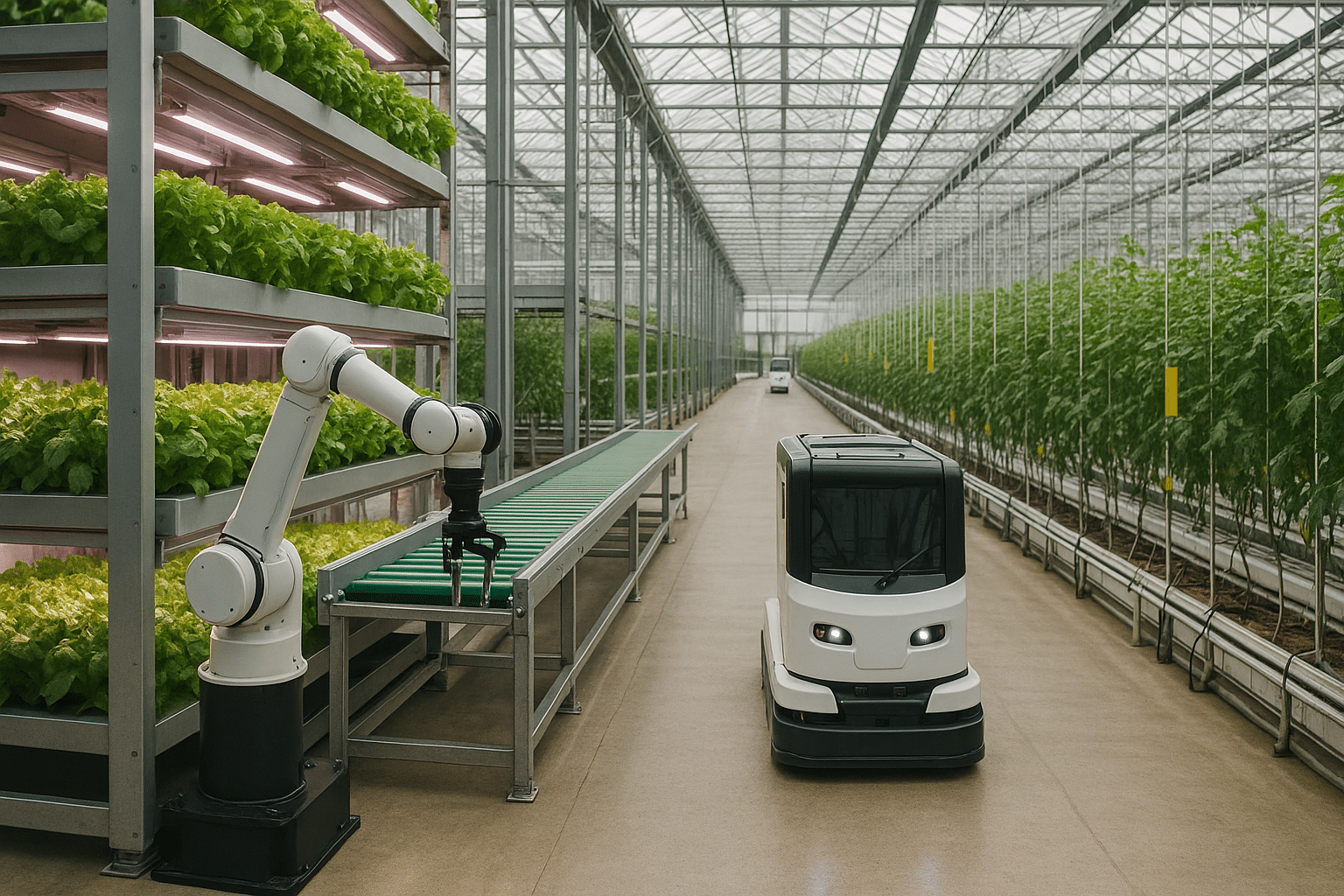Key Takeaways
- With the rise of indoor farming automation, most greenhouses in Europe are operating at Level 3 automation, with increasing transition toward AI-assisted Level 4 systems.
- Vertical farms previously aimed for full automation but are now favoring sustainable and cost-effective Level 4 solutions.
- Automation in Europe’s controlled-environment agriculture (CEA) is shaped by ROI concerns, energy costs, and system integration maturity.
- Robotic harvesters and interoperable platforms are key enablers in both greenhouses and vertical farming.
- Adoption varies widely by region and crop type, but a shared emphasis on reducing labor and increasing consistency is evident.
The Current State of Automation in Europe Indoor Farming
Controlled-environment agriculture (CEA) in Europe is undergoing a significant transformation as farms integrate more sophisticated automation systems. European growers—especially in the greenhouse and vertical farming sectors—are increasingly looking toward automation as a means to address labor shortages, optimize crop yields, and improve operational efficiency.
What The Data Says
European CEA in 2025 is moving from stand-alone tools to integrated automation stacks. Growers are linking climate computers, root-zone and canopy sensors, moving-gutter systems, and farm OS platforms to close the loop from sensing to control. AI is shifting from dashboards to day-to-day set-points and forecasting (e.g., multi-hectare rollouts), while targeted robotics—tomato harvest, leaf removal, and tray conveyance—are reaching commercial use where labor savings are clearest. At the same time, lighting and temperature strategies are being co-optimized for yield and energy efficiency, reflecting tighter alignment between automation and power costs.
This landscape is also consolidating: some sensing/automation vendors are exiting or being acquired, and education/R&D partnerships continue to backfill skills for more autonomous operations. If you’re deciding where to invest—interoperability, AI control, robotics, or energy-aware retrofits—we can quantify ROI, map vendors, and benchmark adoption across Europe’s greenhouse and vertical farming segments.
Explore how we can support your due diligence and go-to-market with tailored analysis here.
Using a six-level automation scale adapted from the Society of Automotive Engineers and repurposed by OnePointOne via Agritecture, the sector is now better equipped to categorize and benchmark progress.
Understanding the Six Automation Levels in CEA
- Level 1: No Automation – All operations are manual.
- Level 2: Basic Growth Automation – Automation of irrigation, lighting, or climate controls.
- Level 3: Conveyor Automation – Use of mechanical systems to reduce manual handling.
- Level 4: Adaptive Automation – Integration of AI and robotics for real-time decision-making and partial autonomy.
- Level 5: System Automation – High-level automation with minimal human oversight.
- Level 6: Full Automation – Fully autonomous farms requiring virtually no human input.
Greenhouse Automation Systems: Moving from Level 3 to Level 4
Most European greenhouses currently operate at Level 3, employing conveyor belts, mechanized irrigation booms, and basic climate control systems. However, many are transitioning into Level 4, where adaptive automation systems driven by AI and machine learning begin to make data-based decisions on tasks like fertigation, microclimate regulation, and pest detection.
Vertical Farming Robotics: Recalibrating After the Boom
Between 2019 and 2021, some vertical farming companies in Europe made ambitious moves toward Level 5 and 6 automation, building facilities with full-scale robotics intended to operate with minimal labor. But following increased scrutiny over capital efficiency and rising energy prices, the industry saw a strategic shift.
“Labor can account for around 40% of total project costs,” says Shlomy Raziel. Grow-tec’s automation platform, focused on fruiting vegetables like tomatoes & cucumbers, aims to reduce this burden through robotics & smart systems. “In most cases, the return on investment in automation is achieved within three to three and a half years.”
Many vertical farms are now embracing Level 4 solutions, striking a balance between automation and energy efficiency. These systems incorporate smart sensors, robotic arms for harvesting, and predictive analytics to reduce OPEX without the full capital burden of Level 6 systems.
The Road Ahead for Indoor Farming Automation Levels in Europe
The evolution of Europe indoor farming automation will continue to be shaped by ROI, regulatory support, and innovation in vertical farming robotics and greenhouse automation systems. Future-proofing facilities will likely rely on scalable platforms that can incrementally progress from Level 3 to Level 5 without full system overhauls.
With renewed interest in adaptive systems and a cautious but forward-looking investment landscape, Europe’s CEA sector is positioning itself for a more resilient and intelligent automated future.
Download the European Indoor Farming report here.


